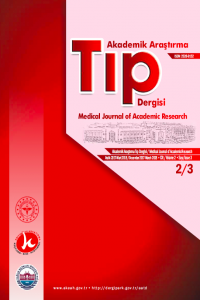Gebelik Hipertrofik Skar ve Keloid İçin Ortak Bir Tetikleyici Olabilir mi? Vaka Sunumu
Hipertrofik skar, keloid, gebelik
Could Pregnancy be a Common Trigger Factor for Hypertrophic Scar And Keloid? A Case Report
Hypertrophic scar, keloid, pregnancy,
___
- 1. Huang, C., et al., Keloids and hypertrophic scars: update and future directions. Plast Reconstr Surg Glob Open, 2013; 1:e25.
- 2. Nakashima, M., et al., A genome-wide association study identifies four susceptibility loci for keloid in the Japanese population. Nat Genet, 2010; 42: 768-71.
- 3. Miller, M.C. and J. Nanchahal, Advances in the modulation of cutaneous wound healing and scarring. BioDrugs, 2005; 19: 363-81.
- 4. Ogawa, R., S. Akaishi, and M. Izumi, Histologic analysis of keloids and hypertrophic scars. Ann Plast Surg, 2009; 62: 104-5.
- 5. Ogawa, R., S. Akaishi, and H. Hyakusoku, Differential and exclusive diagnosis of diseases that resemble keloids and hypertrophic scars. Ann Plast Surg, 2009; 62: 660-4.
- 6. Ogawa, R., et al., Keloids and Hypertrophic Scars Can Now Be Cured Completely: Recent Progress in Our Understanding of the Pathogenesis of Keloids and Hypertrophic Scars and the Most Promising Current Therapeutic Strategy. J Nippon Med Sch, 2016; 83: 46-53.
- 7. Akaishi, S., et al., Nd:YAG Laser Treatment of Keloids and Hypertrophic Scars. Eplasty, 2012; 12: e1.
- 8. Moustafa, M.F., M.A. Abdel-Fattah, and D.C. Abdel-Fattah, Presumptive evidence of the effect of pregnancy estrogens on keloid growth. Case report. Plast Reconstr Surg, 1975; 56: 450-3.
- 9. Park, T.H. and C.H. Chang, Keloid recurrence in pregnancy. Aesthetic Plast Surg, 2012; 36:1271-2.
- 10. Ziegler, U.E., [International clinical recommendations on scar management]. Zentralbl Chir, 2004; 129:296-306.
- 11. Fong, E.P. and B.H. Bay, Keloids - the sebum hypothesis revisited. Med Hypotheses, 2002; 58: 264-9.
- 12. Arima, J., et al., Hypertension: a systemic key to understanding local keloid severity. Wound Repair Regen, 2015;23: 213-21.
- 13. Huang, C. and R. Ogawa, The link between hypertension and pathological scarring: does hypertension cause or promote keloid and hypertrophic scar pathogenesis? Wound Repair Regen, 2014;22: 462-6.
- 14. Branski, L.K., H.O. Rennekampff, and P.M. Vogt, [Keloid and hypertrophic scar treatment modalities. An update]. Chirurg, 2012; 83: 831-4, quiz 845-6.
- 15. Huang, D., K.H. Shen, and H.G. Wang, Pressure therapy upregulates matrix metalloproteinase expression and downregulates collagen expression in hypertrophic scar tissue. Chin Med J (Engl), 2013; 1263321-4.
- 16. Rabello, F.B., C.D. Souza, and J.A. Farina Junior, Update on hypertrophic scar treatment. Clinics (Sao Paulo), 2014; 69:565-73.
- 17. Rha, E.Y., et al., Topical Application of a Silicone Gel Sheet with Verapamil Microparticles in a Rabbit Model of Hypertrophic Scar. Plast Reconstr Surg, 2016;137: 144-51
- ISSN: 2528-9152
- Başlangıç: 2016
- Yayıncı: Keçiören Eğitim ve Araştırma Hastanesi
İleri Yaşta Nadir Bir Göğüs Ağrısı Nedeni
Çiğdem HACIFAZLIOĞLU, Veysel KAPLANOĞLU, Selma UYSAL RAMADAN
İç Hastalıkları Servisine Yatırılan Hastalarda Hiponatreminin Değerlendirilmesi
Yasemin AYDOĞAN, Oktay ÜNSAL, Esin BEYAN
Faruk SAVAŞ, Handan GÜLEÇ, Akın Yurdal KEPEK, Esra ÖZAYAR, Dilek SARICI, Eyüp HORASANLI
İnguinal Lenf Nodu Metastazı Olan Burned-Out Testiküler Kanser: Olgu Sunumu
Selçuk SARIKAYA, Cihat ÖZCAN, Erman DAMAR, Gülçin GÜLER ŞİMŞEK, Ömer Faruk BOZKURT, Öztuğ ADSAN
Yaşlılarda Kalça Kırıklarının Epidemiyolojik Özelliklerinin Retrospektif Analizi
Mustafa Caner OKKAOGLU, Mahmut ÖZDEMİR, Hakan ŞEŞEN, Anıl TAŞKESEN, İsmail DEMİRKALE, Murat ALTAY
Meral ÇEVİK, Yunsur ÇEVİK, Dilaver TENGİLİMOĞLU, Murat DAŞ
Gülçin GÜLER ŞİMŞEK, Hakan BULUŞ
Gebelik Hipertrofik Skar ve Keloid İçin Ortak Bir Tetikleyici Olabilir mi? Vaka Sunumu
Soner TEZCAN, Fatih TEKİN, Mehmet SÜRMELİ, Mehmet Çağatay FALCIOĞLU, Ömer Faruk TANER, Furkan KARABEKMEZ
